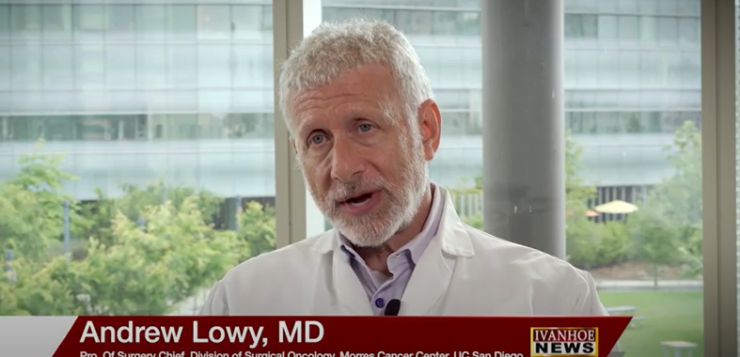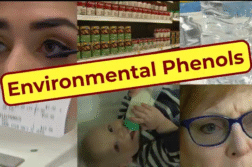Andrew Lowy, MD, Professor of Surgery and Chief of the Division of Surgical Oncology at Morres Cancer Center, UC San Diego, talks about a new way to treat pancreatic cancer.
Is the number of people diagnosed with pancreatic cancer each year surprising?
LOWY: Yes. Many people think of it as a rare disease, but in terms of comparing it to some of the other more common cancers, like lung cancer or breast cancer, the incidence is much lower. However, it still affects close to 60,000 new patients a year. The real issue is the mortality rate which remains high. Even though its incidence is lower than a lot of other cancers, it’s now the third leading cause of cancer death. It’s estimated by 2028 it will be the second leading cause of cancer death in the United States. One of the primary reasons is the late diagnosis of the disease in most patients. Over half of the patients are diagnosed when the disease has already spread to another organ or tissue.
Is late diagnosis because there are no symptoms?
LOWY: It’s because the symptoms are very nonspecific… things like weight loss, vague abdominal or back pain. We don’t obviously have a screening protocol or early diagnostics for it because the incidence is not high enough to make a test feasible from many different perspectives. The other issue is that it has an inherently challenging biology, meaning that there is inherent resistance to medications. Some of the characteristics of cancers that have made them susceptible to immunotherapy are not in play for pancreatic cancer at this time. So, the treatment options are more limited currently than they are for many other cancers.
So, it’s kind of like a cancer that’s hard to penetrate and get inside of it?
LOWY: Yes. The pancreatic cancer cells attract a unique tumor microenvironment, meaning that what we think of as the cancer is a conglomerate of a host of different cell types as well as a bunch of scar-like tissue which is produced by cells that the cancer cells themselves attract. So, it creates this little microenvironment, or new organ, as we talked about. One of the characteristics of that is to limit the ability of drugs to penetrate the microenvironment.
How would you traditionally fight this cancer? With chemo, with radiation?
LOWY: The treatment for almost all patients with pancreas cancer is to get chemotherapy, even those who are earlier stage and amenable to having an operation to remove the cancer. Chemotherapy is a mainstay of treatment because it’s the only treatment we give patients that can go anywhere in the body a cancer cell can go. Radiation is used very selectively. It’s not a central part of pancreas cancer treatment for most patients. For a minority of patients, surgery is still an important part of treatment because only the patients who have an operation are eligible to potentially be cured.
With pancreatic cancer, is it like the chemo is knocking on the door but can’t get in and really penetrate?
LOWY: Yes. We don’t really understand it well enough at this point because there are clearly patients who do respond very well to chemotherapy. So, clearly the drugs are getting in. Then, there’s others that don’t respond well. Many of our models of the disease done in mice tell us that the drug’s not getting in. This is replicated in patients when it’s been tried to be studied. It’s a topic we don’t understand well, but well-accepted in a subset of patients’ drug delivery is part of the problem.
Can you explain what’s going on with this new therapy?
LOWY: We have been working in collaboration with a group in San Diego at the Sanford Burnham Prebys Research Institute to study a small peptide which is a little chain of amino acids that was discovered called IRGD. The way this was discovered is they were looking for peptides that would selectively bind to the blood vessels within cancers as opposed to our normal blood vessels with the idea that we would want to try to deliver drugs selectively to the cancer. This peptide has unique properties in that it binds to receptors on the surface of the tumor blood vessels and then opens little channels in the blood vessel to allow drugs that are co-administered to get into the cancer. There have been several studies conducted, particularly in other cancers, demonstrating that drug penetration did appear to improve. We collaborated with this group because of our interest and expertise and pancreas cancer modeling to show that IRGD in combination with chemotherapies used for pancreas cancer did in fact improve the survival of mice that genetically are engineered to get pancreas cancer. The recent work that we did in collaboration with them and Kazuki Sugahara, a scientist who moved from the Sanford Burnham Prebys to Columbia, were studies to understand what was happening once IRGD got into the tumor microenvironment. These studies showed that the IRGD was able to bind a receptor that was present on the scar-like cells, the cancer-associated fibroblasts that are attracted to the tumor, and then subsequently onto the tumor cells themselves. It kind of travels through the microenvironment along with the drugs that are co-administered. In this study, we showed that the mice lived longer, and the number of metastases was limited. That was very exciting because a study was done in Australia which essentially replicated the findings we had in the mice in that the typical drugs used for pancreas cancer patients when they were given with IRGD, we saw about double the number of responses. Nearly every patient’s cancer was controlled, meaning that at least it didn’t grow, or it shrank which is extremely unusual.
That seems like an incredible breakthrough.
LOWY: It’s very exciting. It’s a small study, but what it has done is propelled the interest in this peptide as a therapy now to the point where later in the calendar year we’re very hopeful there’s going to be a clinical trial done in the United States. We call it a confirmatory trial where there’ll be patients with advanced pancreas cancer who are randomized to receive either the standard chemotherapy or the standard chemotherapy plus IRGD to see if we can replicate those results in a larger group.
Will that be conducted here?
LOWY: That will be led by UC San Diego and done as part of the National Cancer Institute’s Clinical Trials Network. The clinical trials group that we work with is called SWOG. They’re going to be leading the trial. But one of our investigators, Greg Botta, is going to be the lead investigator on the study.
You have patients who basically have a death sentence by the time they know they have this cancer. And now you’re saying you’re stopping it in its tracks? How amazing is this?
LOWY: One of my aspirational career goals is to cure this disease. To do that, we must discover drugs and get them into patients. But pancreas cancer is a difficult disease. Unfortunately, just about every few months we see reports of a clinical trial that was promising at the outset reported as negative in this disease. So, I’m always cautious. I think that IRGD is a therapy that has a significant amount of high-quality preclinical studies that have been done to back its mechanism of action. And now, we have a study in patients that looks very promising. So, I’m very hopeful but always a bit cautiously optimistic.
Is IRGD something that could be beneficial in a lot more cancers than just pancreatic?
LOWY: It absolutely could because its properties are not specific to pancreas cancer themselves. What’s necessary is that those receptors be present in tumor blood vessels. Some of the initial studies were done in breast cancer models, but there have also been studies done in a variety of cancer types as well. The beauty of it is that the small peptide in the study done in the pancreas cancer patients showed no side effects by adding it. If you can imagine getting more drug into the tumor, you might be able to give less drug to the patient. These drugs are the ones that cause all the side effects that are unpleasant for patients. So, in theory, if everything worked out as we hope, we could get more efficacy with less side effects to achieve a better result. And that would really be a homerun.
How do you deliver it?
LOWY: It’s given intravenously each time chemotherapy is given.
You were talking about the results of the clinical trial in mice. Do you have any kind of specifics like 50 percent of the mice showed the cancer quit growing? Was it 75 percent?
LOWY: For point of reference, with the two drugs that are a standard of care in pancreas cancer, the typical response rates in patients with Stage 4 pancreas cancer are around 25% or so. So that means 25% of the patients will have their cancers, their largest cancer, that we’re measuring shrink by 30% or more in its diameter. In this patient study, that rate was 50%. Then, we look at something else called the disease control rate. Disease control rate means patients in whom either had a response, or the cancer didn’t grow, because if you have an ineffective therapy, the cancer is going to grow. That number was 93%. So, in 93% of the patients the cancer either did not grow or it shrank which means there was benefit. If we’re in the 90% range of disease control rate, that’s amazing. We need to replicate this in a much larger group. The new study will be a little over 100 patients.
So, how would this work long term? Would these patients have to be on some type of medicine?
LOWY: So, it’s a therapy to enhance the efficacy of existing chemotherapy. There is some other information suggested by some preclinical studies including our own with the mice that metastases are inhibited. We think that IRGD does have some effect on its own in causing a decrease in the ability of cancer cells to move. We must learn about that a bit more. We also have some early data suggesting that it not only could improve the access of drug to the tumor, but it may allow access of cancer-fighting immune cells to the tumor. If that’s the case, there may be opportunities to use IRGD as a type of immunotherapy or co-administered immunotherapy. There’s a lot more work that needs to be done in this space, but we’re very excited that there may be other aspects of the peptide which can lend themselves to enhancing other types of therapy.
Interview conducted by Ivanhoe Broadcast News.
END OF INTERVIEW
This information is intended for additional research purposes only. It is not to be used as a prescription or advice from Ivanhoe Broadcast News, Inc. or any medical professional interviewed. Ivanhoe Broadcast News, Inc. assumes no responsibility for the depth or accuracy of physician statements. Procedures or medicines apply to different people and medical factors; always consult your physician on medical matters.
If you would like more information, please contact:
MICHELL BRUBAKER
858-210-0854
Sign up for a free weekly e-mail on Medical Breakthroughs called First to Know by clicking here




